The Ultimate Guide To Special Effects Filters For Digital Photography

In digital photography, creating stunning images goes beyond technical skills and equipment. Photographers unleash creative potential by artistically manipulating captured moments. Special effect filters are essential tools, enabling visual storytellers to craft extraordinary visuals that captivate and move audiences.
They offer endless creative possibilities, from surreal color tones to geometric patterns and vintage charm. Photographers can push artistic boundaries and transform ordinary scenes into captivating narratives that spark curiosity and ignite imagination.
Special effect filters in digital photography allow photographers to express their unique perspectives and emotions, convey messages, and create resonant visual experiences.
They empower photographers to transcend reality, experiment, and produce visually stunning masterpieces that leave a lasting impression.
Table of Contents
Ultimate Guide to Special Effect Filters For Digital Photography
Using special effect filters for digital photography effectively is a challenge. To win this challenge, you need to have in-depth knowledge about the filters and how special filters work. Below, I have talked about everything that, as a photographer, you should know about spart effect filters.
How Special Effect Filters Work

In photography and filmmaking, special effect filters serve as optical tools to modify the visual characteristics of images. Typically crafted from glass or resin, these filters attach to the front of a camera lens. Each filter type aims to achieve specific artistic or practical outcomes.
For instance, color filters manipulate the spectrum of colors, graduated filters control exposure variations across the frame, polarizing filters selectively block certain light waves, and neutral density filters regulate the overall light intake.
Here’s how some of the standard special effect filters work:
Color Filters:
These filters alter the color balance of an image by selectively blocking specific wavelengths of light. For example, a red filter will enhance red tones while reducing blues and greens. This can be used to create dramatic effects or correct color casts.
Polarizing Filters:
Polarizing filters reduce glare and reflections from non-metallic surfaces such as water and glass. They selectively block light waves oscillating in a particular direction, improving color saturation and contrast in the final image.
Neutral Density Filters:
Neutral density (ND) filters reduce the amount of light entering the lens without affecting the color or hue of the image. These filters are helpful in bright conditions when you want to use longer exposure times or wider apertures for creative effects, such as capturing motion blur or achieving shallow depth of field.
Graduated Neutral Density Filters:
Graduated ND filters are similar to standard ND filters but have a graduated density, with one half being clear and the other half being darkened. They are often used in landscape photography to balance the exposure between the bright sky and the darker foreground, resulting in a more evenly exposed image.
Soft Focus Filters:
Soft focus filters create a smooth and dreamy appearance by diffusing light rays, which reduces the image’s overall sharpness. This can create a romantic or ethereal mood, particularly in portrait photography.
Star Filters:
Star filters produce a starburst effect around bright light sources by using a grid of thin lines etched onto the surface of the filter. These lines diffract light, creating the illusion of multiple points of light radiating outward from the source.
Fisheye Lenses:
While not technically filters, fisheye lenses are ultra-wide-angle lenses that produce a distorted, hemispherical image. This effect can be used for artistic purposes or to capture wide panoramic views.
How To Choose the Right Filter

Choosing the right filter for your photography can significantly impact the outcome of your images. Whether you’re an amateur or a professional photographer, selecting the appropriate filter can dramatically enhance your photography. Filters provide vast creative possibilities, allowing you to achieve unique visual effects, emphasize specific colors, and control light and exposure with precision.
If you want to create striking and surreal images, consider using a prism or kaleidoscope filter. These filters can split light into multiple beams, creating captivating patterns and distortions. You can also experiment with color filters to add a pop of vibrancy to your photos. By enhancing specific colors, you can create a dramatic and stylized look.
For more subtle effects, explore the use of neutral-density filters. These filters reduce the amount of light entering the lens, allowing you to control the depth of field and achieve longer shutter speeds. This technique is beneficial for capturing motion blur and creating a sense of movement in your images.
Tips for Using Special Effect Filters

Understanding their strengths and limitations is essential to maximizing the effectiveness of special effect filters. Experimentation is key, along with paying attention to composition, lighting conditions, and the desired mood or atmosphere of the final image.
Additionally, avoiding common mistakes like overusing filters or neglecting proper cleaning and maintenance can ensure optimal results. Photographers should be creative during photoshoots, and using special effects filters is a great way to achieve this.
If you need ideas for a creative photoshoot, I suggest you read our other blog. We have shared some of the best creative Photoshop ideas there.
DIY Effect Filters For Digital Photography

The concept of do-it-yourself (DIY) filters emerges as a compelling solution. DIY filters are a budget-friendly, creative option for photographers seeking unconventional techniques.
The beauty of DIY filters lies in their versatility and accessibility. Photographers can repurpose everyday materials like sunglasses or plastic bags into creative tools that enhance their images. With a touch of resourcefulness, creating homemade lens hoods and making softboxes and diffusion filters from household items offers boundless possibilities for experimentation and innovation.
DIY filters give photographers creative freedom without financial burden. They enable them to manipulate light, color, and texture to achieve diverse visual effects, from subtle enhancements to artistic distortions. These filters empower photographers to infuse their unique style into portraits and landscapes.
Creating DIY filters is a rewarding, educational journey. It encourages photographers to experiment, think creatively, and understand light interaction. DIY filters boost creativity and are one of the best budget-friendly options you can go for.
Future Trends Special Effect Filters For Digital Photography

The rapid advancements in technology are transforming industries worldwide, and special effect filters are no exception. The future of special effect filter tools looks bright, with the emergence of intelligent filters leading the way.
Smart filters take traditional presets to the next level by offering connectivity features and adjustable settings. This means photographers have more control over their creative process, allowing them to explore new possibilities and create stunning images.
Smart filters let photographers adjust colors in real time, enabling precise effects. They integrate with other editing tools for a smoother workflow. The future of these filters promises increased accessibility, allowing photographers of all levels to express their creativity.
In summary, the future of special effect filters is promising, with intelligent filters offering unprecedented control, connectivity, and accessibility. As technology evolves, photographers can look forward to pushing the boundaries of creativity and producing awe-inspiring imagery.
Conclusion
In conclusion, special effect filters for digital photography are an invaluable asset. It offers endless possibilities for artistic expression and visual storytelling. Embrace filter usage and experimentation to unleash creativity and elevate photography. Special effect filters are powerful tools that enable photographers to manipulate and transform their images imaginatively. Photographers can make eye-pleasing visuals with color correction, distortion, blur, and texture overlays. These techniques evoke emotions and captivate viewers.
FAQs
What are special effect filters?
Special effect filters are optical accessories used in photography to alter the appearance of images by modifying light transmission, color balance, or other optical properties.
How do I know which filter to use?
Filter choice depends on shooting conditions, desired effects, and personal preferences. Experimentation and familiarity with each filter’s characteristics are vital in determining the most suitable option for a given situation.
Can I use multiple filters simultaneously?
It’s possible to stack multiple filters together to achieve combined effects. However, careful consideration should be given to potential vignetting, image degradation, or color shifts that may occur.
Are special effect filters only for professional photographers?
No, special effect filters are accessible to photographers of all skill levels, from amateurs to professionals. They offer a versatile tool for enhancing creativity and adding unique visual elements to photographs.
Can I achieve similar effects through post-processing software?
While some effects can be replicated in post-processing, special effect filters offer distinct advantages, such as real-time previewing, in-camera adjustments, and preserving image quality without digital artifacts.
